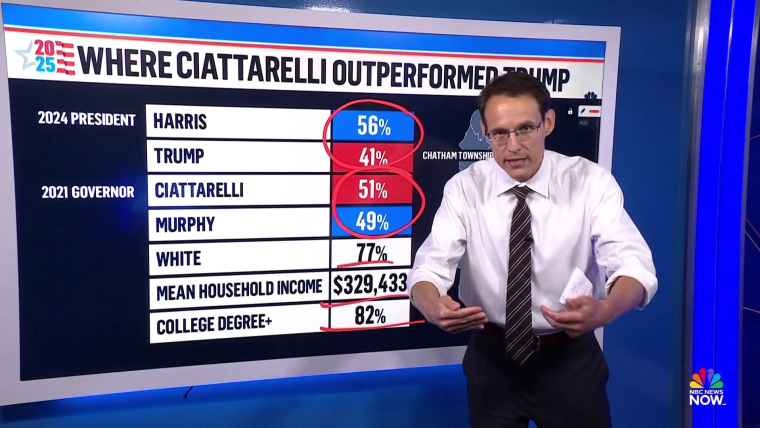New Jersey delivered some of the nation’s most dramatic coalition shifts in the 2024 presidential election. Now, those shifts are setting the table for this year’s hard-fought governor’s race — and raising big questions nationally about where communities like these are going in future elections.
For starters, President Donald Trump’s 2024 surge among nonwhite voters in the New York City metro area caught much of the political world by surprise. But questions remain about whether Republicans can sustain this coalition long term.
An analysis of municipal-level election results in New Jersey, coupled with data from the U.S. Census Bureau, provides a detailed demographic and geographic snapshot of where Democrats and Republicans have grown their support fastest in recent elections. By examining changes since 2012 — the most recent presidential election without Trump on the ballot — a clear picture of shifting party coalitions emerges.
Support for Trump has exploded in densely populated, heavily nonwhite, formerly industrial cities like Paterson, Perth Amboy and Passaic in the New York City metro area. Republican growth that was slowly developing since 2012 surged dramatically in 2024.

Meanwhile, Democratic candidates have found growing strength in New Jersey’s shore towns, affluent suburbs populated by college-educated professionals, and places popular with retirees.
These communities will become crucial laboratories going forward, testing whether this 12-year political realignment can outlast Trump.
But the picture will be far from clear, and different political characters often encourage different political results. Republican Jack Ciattarelli’s previous bid for New Jersey governor in 2021 produced a tight race — but he did it with a coalition that looked much different than the one that would emerge for Trump in 2024.
The biggest question heading into future elections is whether these shifts represent a durable transformation of state (and national) politics or merely a Trump-specific phenomenon. These communities provide a testing ground for the answer.
The biggest shifts toward Democrats
Biggest shifts since 2012
More than half of this nearly all-residential beach town of 331 people, located 2 miles south of the final stop on NJ Transit’s Jersey Shore train line, work in finance or management jobs. The population that works from home is also well above the state average: 45% for Mantoloking, compared to 13% statewide. The mean household income was $484,326, and the average sale price of the 10 homes sold in this borough in 2024 was $4.8 million.
It’s still Republican territory, but not to nearly the same extent it was pre-Trump, exemplifying shifts among wealthier and more educated voters.
This location is perhaps most famous to New Jerseyans for its eponymously named shopping center, The Mall at Short Hills. Originally opened in 1961 with the tagline “5th Avenue in the Suburbs,” the mall and the area around it have grown into that aspirational billing.
Today, Short Hills has a mean household income of $512,637, the second highest in the state. Among residents 25 and older, 60% hold advanced degrees, the highest share for any place of its size in the state. Asian residents make up 38% of the population, with half of them being Indian American.
Biggest shifts since 2016
This is another small beach town, the farthest you can get down the Jersey Shore — at the southern tip of the Jersey peninsula. Nearly all the shops and dining are in the larger Cape May city, 10 minutes to the east, but this mostly residential community has a high population of older individuals, with a median age of 70.9. Home values are $1.4 million, among the top 10 places in South Jersey.
Located on the banks of the Delaware River in western New Jersey, Frenchtown is a quaint river town and popular day trip destination known for its art galleries and boutiques. The 70-mile Delaware and Raritan Canal trail, which begins just north of town, is popular with pedestrians and bikers alike. A narrow bridge connects Frenchtown to rural Bucks County, Pennsylvania — itself a perennially important county in Pennsylvania politics.
One in 10 residents in Frenchtown are involved in “arts, design, entertainment, sports, and media occupations,” the second highest concentration in the state. (In recent years, “Eat, Pray, Love” author Elizabeth Gilbert lived and owned a store in town.) Among adult residents, 41% are white with college degrees or higher, above the 27% average for New Jersey overall.
Biggest shifts since 2020
Avalon has long been an affluent shore town: Ed McMahon would often talk up his weekends there on “The Tonight Show with Johnny Carson.” Avalon now has the state’s fifth-oldest population, with a median age of 74.1. The average sale price of a home in Avalon last year was $2.8 million.
A retirement community in South Jersey, this planned development was under active buildout from 1971 to 1986. Leisuretowne has grown to 2,255 homes, and the current median age is now 72.5.
The biggest shifts toward Republicans
Biggest shifts since 2012
This largely industrial neighborhood is tucked underneath the Gov. Alfred E. Driscoll Bridge, one of the widest in the world at 15 lanes. Its accessibility to the Garden State Parkway, I-95 and the Outerbridge Crossing, connecting New Jersey to New York, make this particularly attractive to large distribution-based companies. FedEx hosts a distribution center here, as does Wakefern Food Corp., best known for its ShopRite subsidiary.
